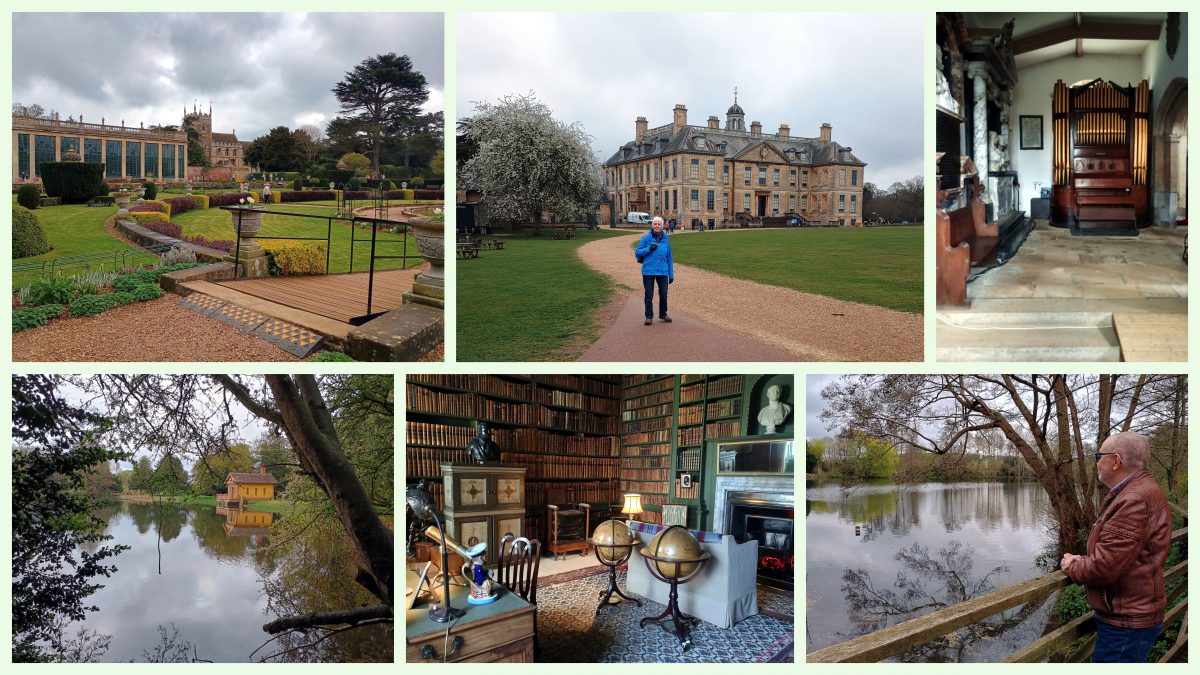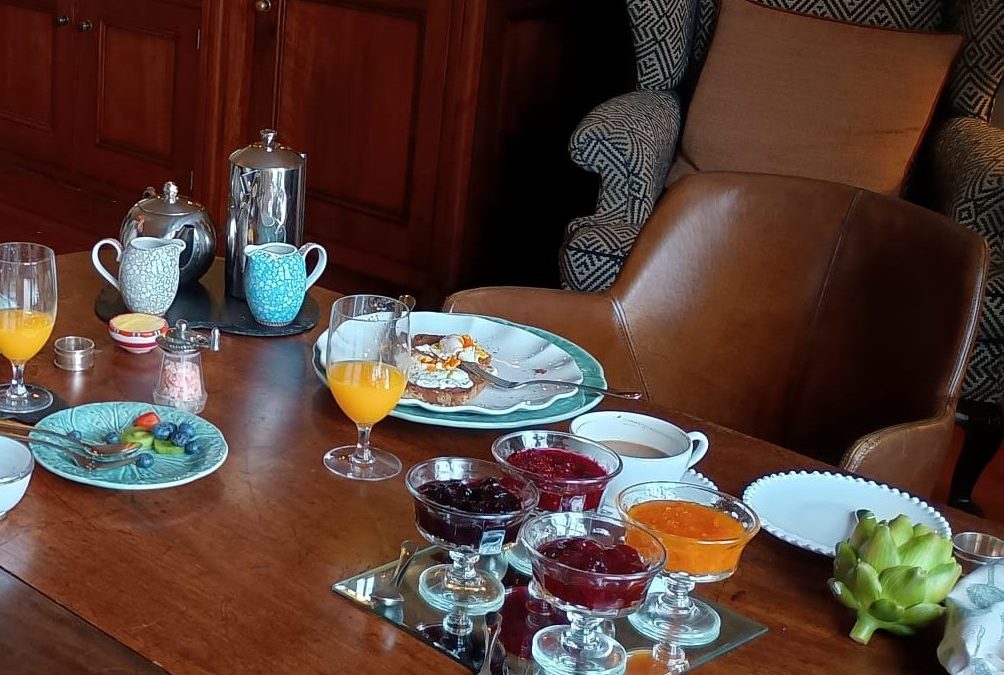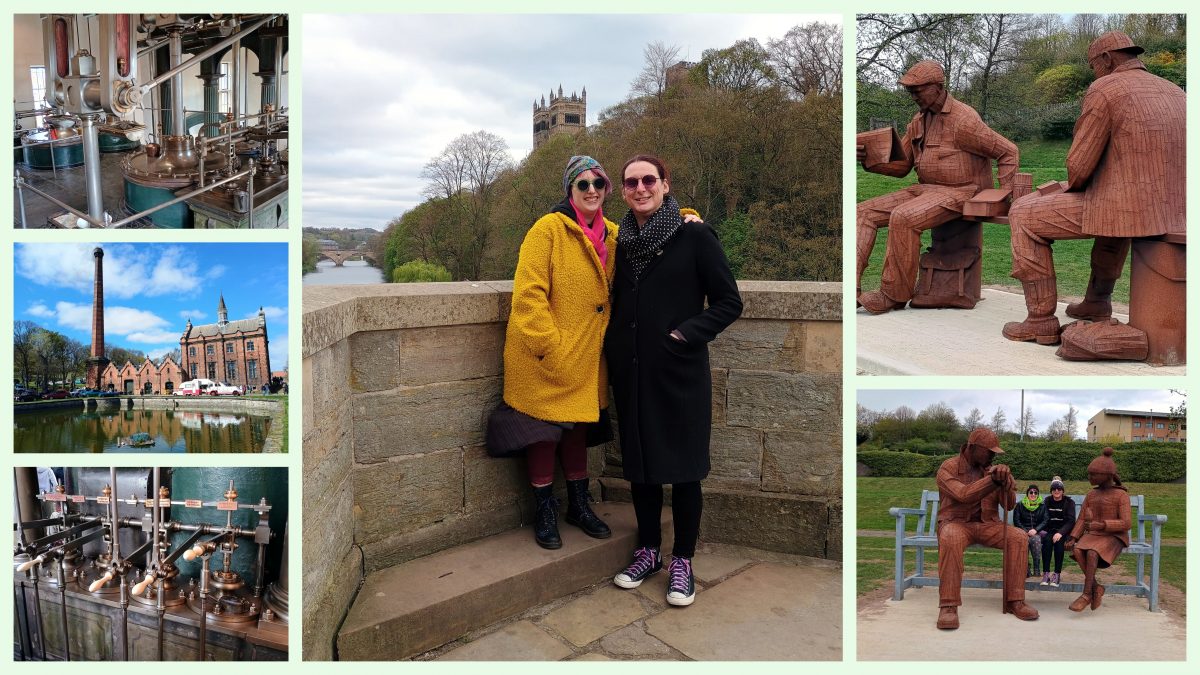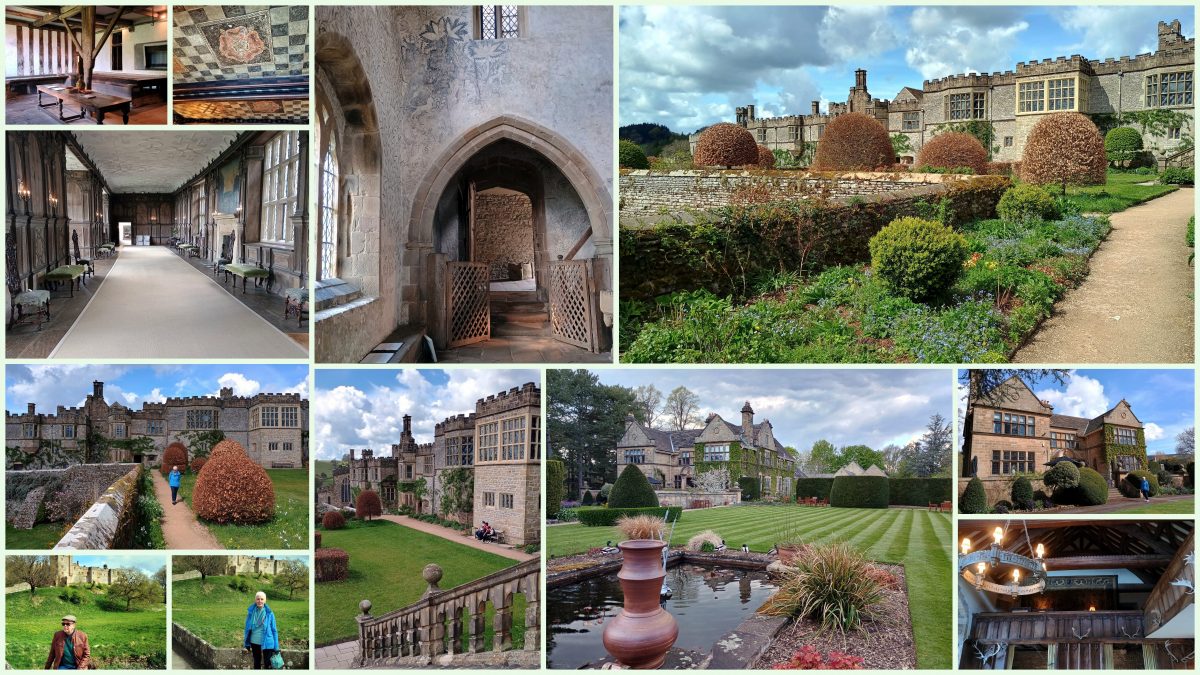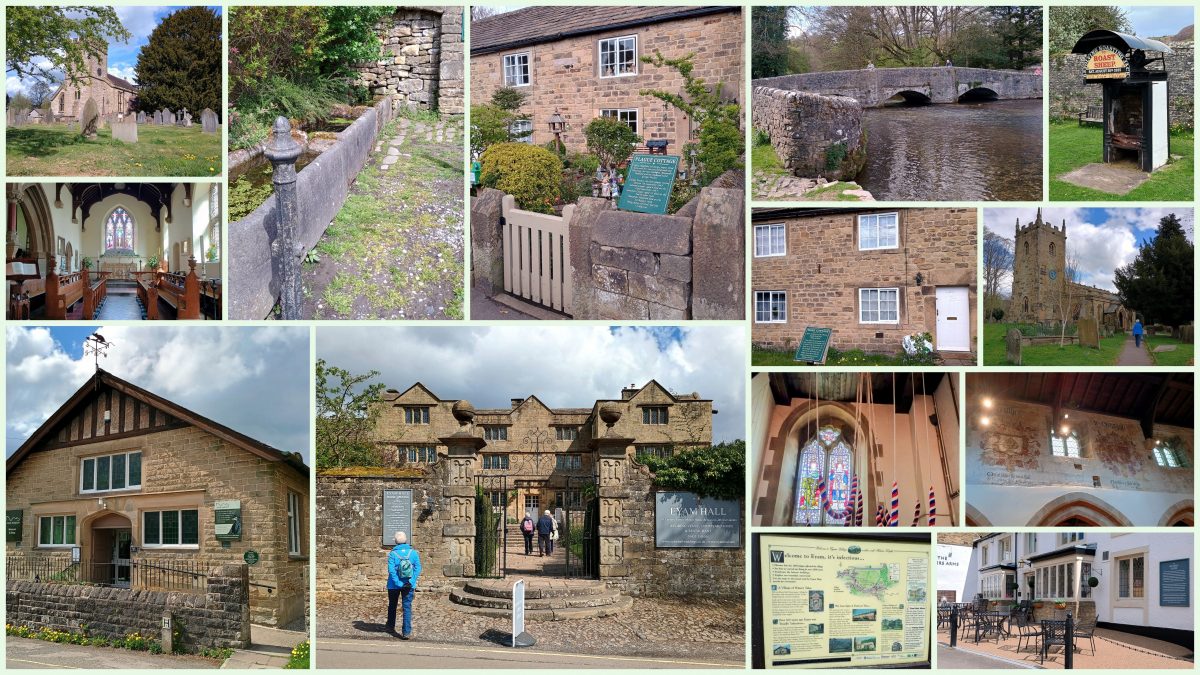Or in this case, a trip to Sunderland last week to visit S&G that did not include catsitting duties, although it is still sad to report that any such future tasks will be to support two cats following the sad demise of the second of the older twins after more than twenty years of domestic ‘harmony’. Also, when I say Easter at Sunderland, it was more a three day break in the middle of a longer break with visits to Easby and Richmond on the way up and Baslow and the Peak District on the way back.
The way up also included a one night stopover at Belton Woods Hotel And Spa, which as well as being a convenient break in the journey is also adjacent to Belton House, a National Trust Estate resplendent with restoration architecture, formal gardens and wilder parkland. We both knew we had visited before but neither could remember anything about the house interior or the gardens. And so it proved the following morning, when nothing about the house internals was remotely familiar, although in our defence, the previous visit was many, many years ago. Anyways, Belton was built in the late 17th century by ‘Young’ Sir John Brownlow. Home to the same family for nearly 300 years, Sir John’s heirs also made their mark on Belton, commissioning the finest designers and craftsmen of their age. It shows in the grand Marble Hall entrance, along with the Chapel Drawing Room and the Chinese Bedroom. Outside is the Italian styled garden, overlooked by a Conservatory with an extensive collection of lush foliage and exotic blooms. The parkland was also extensive and we managed to complete a circular walk that included the Boathouse and lake. Well worth a visit, especially if you’re staying at the aforementioned hotel, from where you can simply walk to this National Trust property – prices are definitely rising though, a recurrent theme on this trip, although in this instance, we were immune as we are still NT Members.
After Melton, we continued our journey North and arrived at Easby Hall late afternoon, which was chosen both for its proximity to Richmond and its unique and rather unusual status as a B&B, even though the building itself is a classic Georgian country house. Greeted by the owners, our lovely room looked directly out over Easby Abbey (more later) and, after a brief rest, we took the advice of the owner and walked the old railway line track into Richmond, which took about thirty minutes. We seized on the opportunity to eat in a local pub (excellent value for money) before returning via the railway track, which runs next to the River Swale for most of the journey. Each morning we indulged in a fabulous breakfast in the Drawing Room, where much of the produce was home grown and/or home made. On our own for all three days, we might well have day-dreamed about indulging in Lord and Lady of the Manor lifestyles. 🙂
Easby Abbey was a pleasant surprise in that so much of the estate was still structurally intact. The impressive ruins lie in picturesque surroundings by the River Swale in North Yorkshire. Easby is actually one of the best preserved monasteries of the Premonstratensian ‘white canons’ (look it up, I had to), with the magnificent refectory, gatehouse and canons’ dormitory remaining. The parish church within the precinct, which is still in use, contains rare 13th century wall paintings and was well worth a visit in its own right! Founded in 1152, Easby Abbey was suppressed in 1536 and within two years most of its buildings had been stripped and demolished. The ruins later became a favourite subject for artists, including JMW Turner. Looking out on the Abbey directly from our bedroom window, we could see the appeal for Turner and his artistic brethren.
Richmond was the focus for the next two days, the first of which was dedicated to the two museums in the town. The first was the Richmondshire Museum. This museum (and I quote from the website) “was founded in 1974 by the Richmond and Dales Soroptimists and opened in 1978. Since then much has been added to make the attraction a ‘must’ for any visitor to the town. The building appears small on the outside but is a veritable ‘Tardis’ once entered. There is a wide range of items on display with the emphasis upon local and social history. Displays include artefacts from the Stone Age to the present day“. What I can tell you is that the Museum incorporates a reconstructed cruck house, which contains a collection of domestic bygones. There is a Leadmining Gallery, which details the industry which flourished in Swaledale and the North Yorkshire Dales until the end of the nineteenth century. The Transport Gallery has a model of Richmond Railway Station. Another room contains the Herriot Set from the BBC’s All Creatures Great and Small, and Barker’s Chemist’s Shop. The Wenham Gallery covers the history of Richmond and district. In 2008 the Museum opened a recreation of the Richmond grocer’s shop where the founder of the Fenwick department store chain began his working life. Some would argue it’s a little cheesy but I disagree and thought it brought the social history of the area to life.
We also went to the Green Howards Regimental Museum, which is the home of this infantry division of the British Army. Of less interest to those turned cold by military history (that includes me), it nonetheless illustrates three centuries of the history of the regiment and houses a poignant and fascinating collection of 3,750 infantry medals and decorations, including 16 Victoria Crosses and 3 George Crosses.
The final day was centred around the walk to Richmond Castle. It consists of four main parts: a triangular main enclosure, an outer enclosure to the east, a keep at the northern corner of the main enclosure, and a small enclosure around the keep. You will be pleased to note that the oldies could still walk the steps up the keep ! The 100-foot (30 m)-high keep of honey-coloured sandstone was constructed at the end of the 12th century by Duke Conan IV of Brittany. The Earldom of Richmond was seized in 1158 by Henry II of England. It was King Henry II who probably completed the keep which had 11-foot (3.4 m)-thick walls. Modern visitors can climb to the top of the keep for magnificent views of the town of Richmond and beyond. I promise we did it!
After a final hearty breakfast, we said our goodbyes and headed up to S&G’s in Sunderland. On the afternoon we took a trip down to the Glass Centre, along with the sculptures installed along the riverside (by Ray Lonsdale, creator of ‘Eleven-O-One, but known to all as Tommy). Disappointing to hear that the Glass Centre now has a projected closing date of July 2026 – sad, but money grabbing halfwits will always win out over cultural and locality heritage, even if it purports to be a National Treasure. The following day, drove to Durham to revisit old haunts, including the cathedral and old market, before a visit to S&G’s location for the civil partnership “after party” (Durham School); followed all that with an excellent evening meal at the Causey Inn, host to the actual CP. On the Sunday, we visited the volunteer run Ryhope Pumping Station which was built in 1868 to supply water to the Sunderland area. The station ceased operation in 1967 – after 100 years of continuous use. The two 100 horsepower beam engines are kept in working order by volunteer members of the Ryhope Engines Trust, and ‘steamed’ periodically for the benefit of visitors, including us. I thought it was magnificent and it is now regarded as one of the finest single industrial monuments in the North East of England and is both a Grade II* listed building and an Ancient Scheduled Monument.
We left Monday lunchtime (but not before losing a very tight Trivial Pursuit on the last night), following a lovely, excellent homecooked Easter meal at G’s parents early Sunday evening. We arrived at Fischer’s Hall in Baslow to find we had been upgraded to the Vernon Room, which was a great bonus as we were there for three nights. The hotel only has eleven rooms but is a lovely example of old fashioned service and attention to detail. Superb, unusual breakfasts and an excellent evening meal in the justifiably acclaimed restaurant were just a couple of highlights of our stay.
On the Tuesday, we revisited one of my favourite haunts as a kid (it must be fifty years since I’ve been to Baslow and this specific part of the Peak District (although admittedly Chatsworth was in essence just down the road from the hotel). We’ve both been since the childhood visits and although we remembered the entrance and walk up to the Hall, very little of the interior was recalled. A former seat of the Dukes of Rutland. It is the home of Lord Edward Manners (brother of the incumbent Duke) and his family. In form a medieval manor house, it has been described by Simon Jenkins as “The most perfect house to survive from the middle ages“. The origins of the hall are from the 11th century, with additions at various stages between the 13th and the 17th centuries, latterly in the Tudor style. According to its website “with 900 years of history, Haddon has much to offer. Brimming with history and stories of old, a remarkable tapestry collection; an early English furniture collection reputed to be the best of its kind in England; and stunning Elizabethan Walled Gardens, recently redesigned by Arne Maynard, Haddon is one of the most significant and oldest heritage destinations in the country“. The collage gives a slight flavour but we would encourage all to visit to experience something different from, say, Chatsworth just down the road. I know which I prefer!
The following day we set off to visit the plague village of Eyam which, despite growing up a stones throw from it I swear I had never visited – anyway, I digress as prior to Eyam we called in to Ashford in the Water to view the Sheepwash Bridge which, whilst not spectacular was, along with the village parish church of the Holy Trinity, well worth the detour. Eyam was far larger than I expected and does in deed major on the 1665 outbreak of Bubonic Plague – it museum, although relatively small, personalises the outbreak with some harrowing family stories, as well as humanising both the struggle and the arbitrary nature of the disease – one such instance was that of Elizabeth Hancock, who was uninfected despite burying six children and her husband in the space of eight days!
There are a number of important buildings in the village, not least the plague cottages of some of the victims of the outbreak, including its first victim. The church of St. Lawrence is also worth a look, as is the churchyard which houses an Anglo-Saxon cross in Mercian style dated to the 8th century, moved there from its original location beside a moorland cart track. It’s Grade I listed and is a Scheduled Monument – it’s covered in complex carvings and is almost complete, but for a missing section of the shaft. The prominent Jacobean-styled Eyam Hall also features, built just after the plague. It was leased and managed by the National Trust for five years until December 2017 but is now run by the owners. I’m guessing there is quite a modern story to tell there. Unusually, we didn’t actually go inside but we did take in a little light refreshment in the Eyam Hall Courtyard. It’s also quite nice to note a little, slightly wicked humour is alive in the village as well – the tourist board signs in with the motif “Welcome to Eyam, it’s infectious…” – only in Yorkshire I’d like to think, far too precious down here in Suffolk. The collage hints at some of the village spirit I think, but it is definitely worth a day of any weary traveller’s time.
One final breakfast and then a reasonably pain free journey home……and again we didn’t spare the horses.

